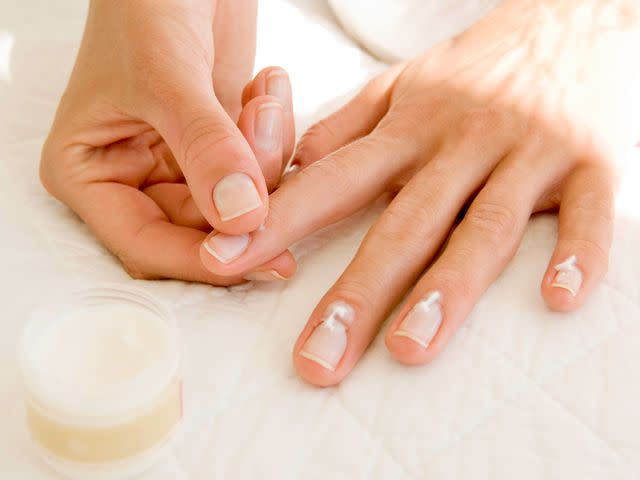What Is Nail Slugging—and Why It's the Simple Solution to Brittle Nails
Get those tips in tip-top shape.
In case you haven’t yet heard, slugging is one of the latest trends in the beauty space. (No, there are no actual slugs involved.) Case in point: #sluggingmethod videos have more than 25 million views on TikTok. It first started in the context of skin, but then hair slugging became all the rage, and now everyone is talking about nail slugging. But, what exactly is it and what can it do for your nails? And can this trendy trick actually help if your nails are in need of serious help? We asked nail experts to weigh in.

Henry Arden/Getty Images
What Is Nail Slugging?
“Nail slugging, an evolution of the popular Korean skin slugging trend, is a new way to hydrate and revive dry or damaged nails,” says Dana Stern, M.D., a board-certified dermatologist and nail specialist. Just like skin slugging involves coating skin in a thick layer of an occlusive ointment (typically Vaseline), so too holds true for nail slugging, during which you coat the nail and cuticle with the same. Unlike cuticle oil, which can quickly get rubbed off, think of nail slugging as deep conditioning for your cuticle and nail—the ointment creates a barrier that really traps moisture in the nail, says nail artist Emma Bedingfield, owner of ENB Nails.
What Kinds of Benefits Can It Have?
Nail slugging can help hydrate both the cuticle and the nail, and promote healthier, stronger growth, as well as preventing splitting and cracking, says Marcela Correa, a medical nail technician and owner of Medi Pedi NYC. It all comes down to the importance of the cuticle. “As the nail’s natural protective seal, the cuticle is the key to a healthy, beautiful nail. It’s like the grout in between the tiles in your shower—it keeps moisture and micro-organisms out of the nail unit,” explains Dr. Stern. When that seal is removed, such as during an aggressive manicure, or becomes dry and dehydrated, it becomes compromised; picture old, dry grout, she adds. Water and moisture is able to enter the nail unit and this can cause all sorts of problems, including redness and swelling, as well as irregular nail growth and issues such as white patches, bumps, thickening, and discoloration.
Who Should Consider Nail Slugging?
“Nail slugging can be beneficial for everyone. The frequency of how often you’re doing it may just change depending on your individual needs and how damaged your nails or cuticles may be,” says Correa. (More on those specifics in a minute.) But to that point, nail slugging is an especially good option for those who have damage from acrylics or gel polish. It’s also a great thing to incorporate into your routine during the winter, as cuticles are naturally drier then, adds Bedingfield. Similarly, Dr. Stern says it’s a good option for those with damaged cuticles as it can help start the healing process.
How Do You Do It?
While slugging itself is most often referred to as the simple act of slathering on some type of thick ointment, there are a few things you should do beforehand in order to maximize the results. Dr. Stern underscores the importance of exfoliating the nail first, in order to ensure that the moisture you’re trying to add back in can better penetrate. Her eponymous Nail Renewal System ($30; amazon.com) contains an exfoliant that relies on glycolic acid to remove damaged nail cells.
The next step is to add moisture using a cuticle oil. Our pick: CND Solar Oil ($10; ulta.com). Apply it liberally all over the nail and on the surrounding cuticle and skin. Then you can move onto the slugging portion. Cover each nail with a thick coat of something such as Vaseline Original Petroleum Jelly ($2; target.com) or Aquaphor Healing Ointment ($5; target.com). “Applying this occlusive layer seals in the cuticle oil so that it will penetrate deeper and provides a protective barrier to help prevent moisture loss,” explains Dr. Stern. To ensure everything stays really locked in, Bedingfield suggests wearing finger gloves or even a regular glove. Do so for at least 15 to 30 minutes, though overnight is ideal.
Again, how often you slug depends on the condition of your nails. Dr. Stern says you can do so every night (although if that’s the case, make sure you’re only exfoliating once per week). Otherwise, the experts agree that making this a weekly or twice-weekly part of your routine is the ideal way to repair dry, brittle nails.
For more Real Simple news, make sure to sign up for our newsletter!
Read the original article on Real Simple.

